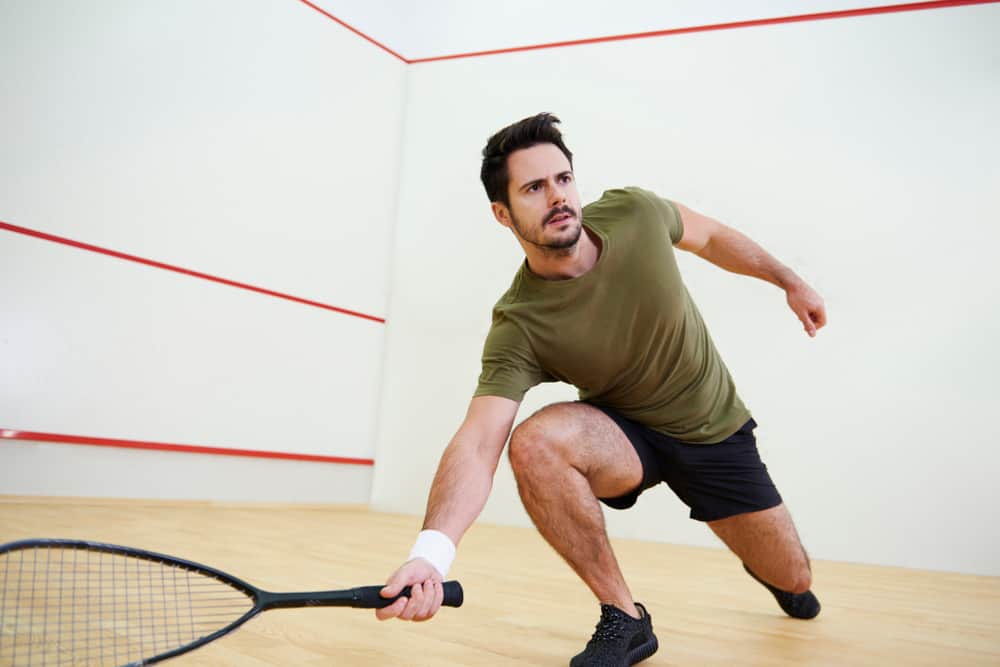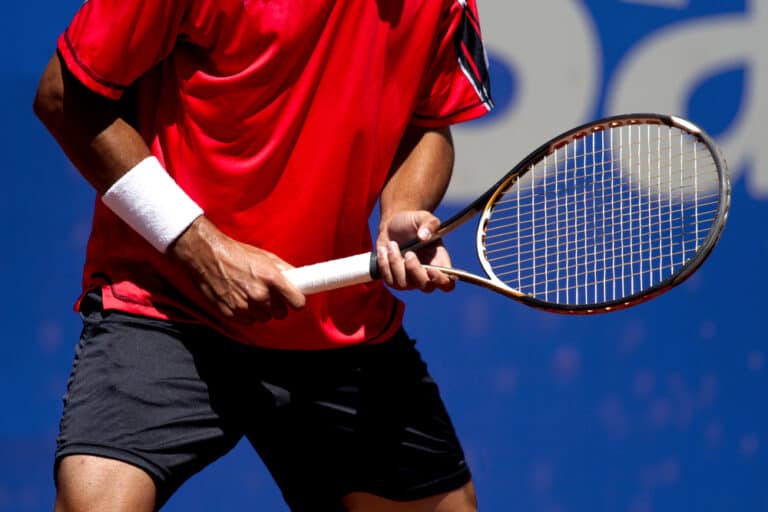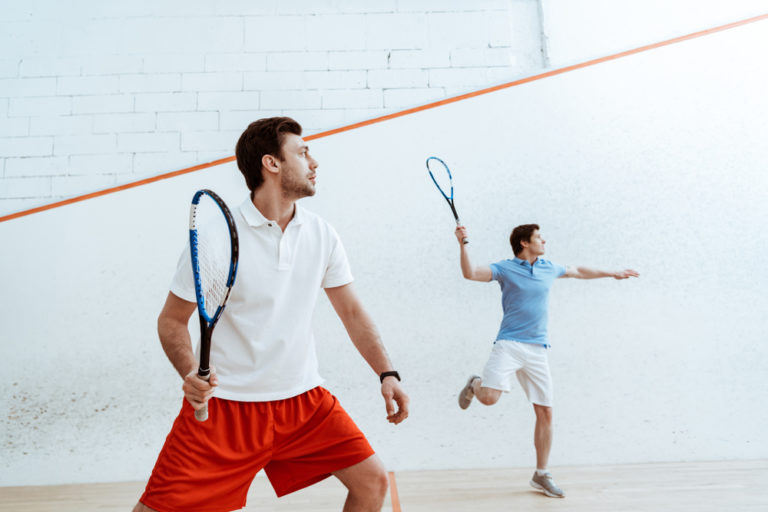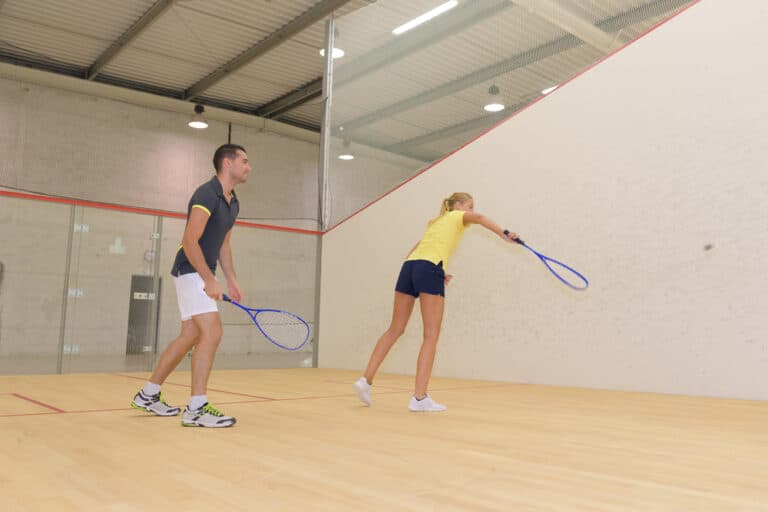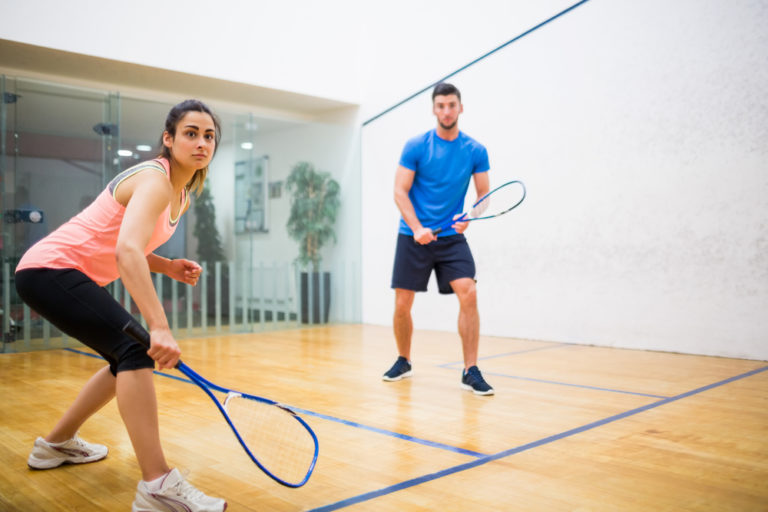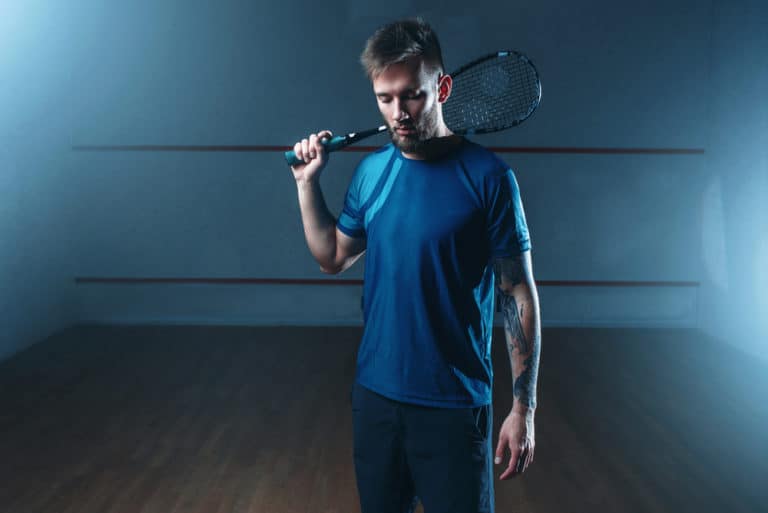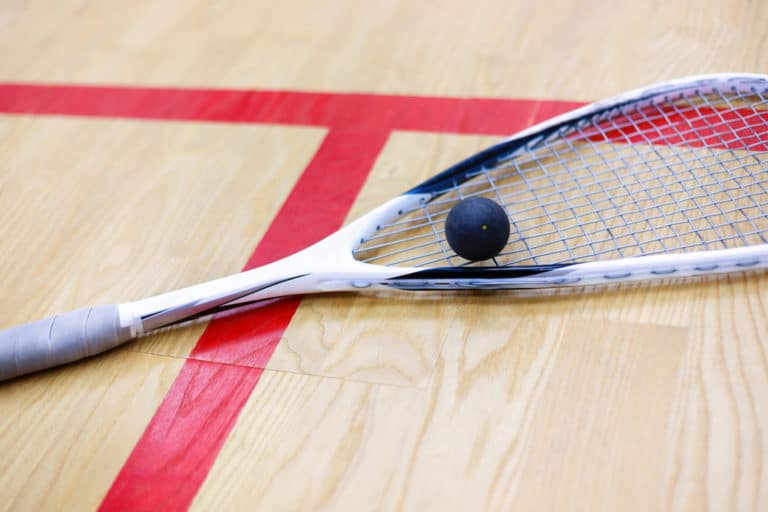What Muscles Does Playing Squash Use?
Squash has a reputation for giving players a full-body workout. This physically-intensive sport places demands on many different muscles in the body due to the wide variety of dynamic actions players perform during a game. So, what muscles get used when playing squash?
Squash playing uses hip, backside, thigh, and calf muscles for sprinting, deceleration, and directional change on the court. Holding and swinging the racket activates muscles in the playing shoulder, arm, and wrist. Core muscles are engaged in most if not all actions performed during a squash game.
Having a clear understanding of the muscles squash uses can help enhance one’s training and performance while also reducing the risk of injury and maximizing the physical benefits of the sport. Let’s have a closer look at the muscles used when playing squash.
The Muscle Biomechanics Of Squash: A Brief Overview
Squash is one of the most physically-demanding racket sports, activating many of the lower body, upper body, and core muscles. The lightning-fast and multi-directional movement of the ball around the squash court requires players to execute diverse and constantly changing actions that engage muscles throughout the body.
The rapid bursts of movement and endurance required during a squash game make full use of fast-twitch and slow-twitch muscle fibers. Squash players need robust and elastic (flexible) muscles to increase the quality of their performance, minimize injuries, and improve recovery time between points, sets, and games.
Every movement involves pairs of opposing muscles working in unison. We can divide the actions squash players perform during a game into the following basic categories:
- running (this includes jumping),
- striking the ball with the racket.
Squash players rarely stand still for more than a few milliseconds because they’re constantly moving in response to the movement of the ball and their opponents. The sport is unique for the intensive sprinting, decelerating, and directional changes involved during each rally.
The intensive running players do in squash principally requires the activation of the lower body muscles of the hip, buttocks, thigh, and calf. Core, shoulder, and arm muscles also play crucial supporting roles when players run on the court.
Striking the ball with the racket is the other fundamental movement in squash. The upper body muscles play the dominant role in this complex action. Playing the squash ball activates the chest, shoulder, arm, and wrist muscles.
Lower Body Muscles Used In Squash
The intensive and dynamic sprinting involved in the average squash game places considerable demands on the lower body muscles. Squash players must make rapid changes between acceleration and deceleration, while also stopping and changing direction multiple times in every rally.
The sprinting movements in squash mostly rely on the hip, backside, thigh, and calf muscles. Upper body and core muscles are also used to stabilize and assist the lower body when running on the squash court.
Hip Flexors
Hip flexors are the muscles enveloping the hip bones. These muscles help produce flexion (bending) in the upper leg. The five hip flexor muscles are:
- sartorius,
- pectineus,
- psoas,
- rectus formis,
- iliacus.
The hip flexor muscles give stability and control to the movement of the legs. This muscle group is necessary for rapid acceleration and deceleration on the squash court.
Quadriceps
The quadriceps are the muscles on the front (anterior) of the thigh. Quads play a critical role when running on the squash court. These anterior thigh muscles are composed of four muscles:
- vastus medialis,
- vastus intermedius,
- vastus lateralis,
- rectus femoris.
When the quadriceps muscles contract, they pull the leg upward (or forward). The quads produce upward leg movement working in tandem with the hamstring muscles.
Hamstrings
The hamstring muscles are located at the back of the thigh. These posterior thigh muscles function in synergy with the quads. Extension of the hamstrings pushes the leg upwards, while their contraction pulls the leg downward (or backward).
The three hamstring muscles are:
- biceps femoris longus,
- semitendinosus,
- semimembranosus.
The hamstring muscles are for accelerating and decelerating on the squash court. Hamstring muscles also enable squash players to make sudden and extreme shifts in direction as they adapt to the ball’s constantly shifting trajectory.
Glutes
Squash playing puts heavy demands on the gluteal muscles. The gluteal muscles stabilize and aid the propulsion of the quad and hamstring muscles when players move around the court. The glutes are composed of the following muscles situated on the backside:
- gluteus maximus,
- gluteus minimus,
- gluteus medius.
The glutes are vital for enabling squash players to change direction rapidly. Gluteal muscles also support and propel players’ legs when lunging for low shots.
Calves
Squash players rely on their calf muscles to move quickly on the court. The two calf muscles consist of the:
- gastrocnemius,
- soleus.
The gastrocnemius muscles are the superficial calf muscles positioned prominently on the posterior of the lower leg. These calf muscles include the lateral head (on the outer side of the calf) and the medial head (on the inner side of the calf). The soleus is a deeper calf muscle positioned underneath the gastrocnemius muscles.
The calves transfer the driving power of the upper leg muscles through the lower leg when running and jumping. Calf muscles are also responsible for foot dorsiflexion, which is the upward bending action of the foot (with the toes toward the knee).
The calves also enable plantar flexion. Plantar flexion is crucial for the movement of the lower body muscles while playing squash. This foot articulation occurs when the heel of the foot is raised in the air while the toes and ball of the foot are kept on the ground.
For example, foot flexion contributes to forward acceleration during sprints. The bending movement of plantar flexion is also involved when lifting the body to play high overhead shots.
Upper Body Muscles That Squash Players Use
The upper body muscles are crucial in squash, which is ultimately a sport whose focus is on hitting a ball with a racket.
To strike the ball with potency and precision, squash players engage the muscles in their chest, shoulder, arms, and wrist. It does not take a squash guru to know that the muscles in the playing arm are engaged more than those of the non-playing arm.
The upper body muscles are also involved when running on the squash court, providing balance during acceleration, deceleration, and directional changes.
Chest
Hitting a squash ball uses the chest muscles (on the right-hand side of the chest for right-hand players and vice versa for left-handers).
The pectoralis major is the principal chest muscle deployed to strike a squash ball. This muscle gives stability and power to the shoulder and arm muscles when executing the swinging movement of the racket.
Shoulder
Squash relies on the shoulder muscles when striking the ball and for moving the arm muscles while running. The primary shoulder muscles used when playing shots are the:
- deltoid,
- scapular stabilizing muscles.
The location of the deltoid muscle is on the upper shoulder (surrounding the shoulder joint). This large muscle is fundamental for arm movements like flexion, extension, and abduction. Squash players use the deltoid muscle on their playing side whenever they raise, swing, and lower their rackets to strike the ball.
In addition, squash players harness the deltoid muscles on both sides of the body when they move their arms while running on the court.
Playing squash also activates the scapular stabilizing muscles such as the serratus anterior, infraspinatus, and the rhomboids (major and minor).
These shoulder muscles give stability (as their name suggests) to the shoulder blade, which provides the foundation for the firm and controlled movement of the upper arm musculature. The scapular stabilizing muscles are critical for hitting squash balls with power and accuracy.
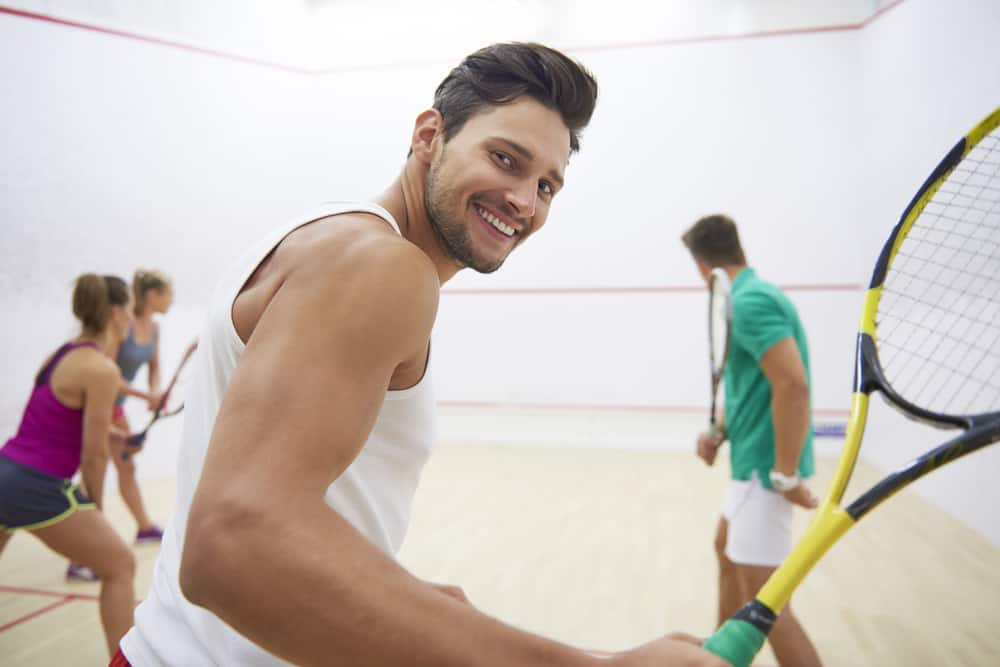
Upper Arm
It’s no surprise that squash playing engages the upper arm muscles extensively. Squash engages these specific upper arm muscles:
- biceps brachii,
- triceps brachii.
Hitting the squash ball calls on the fast-twitch muscle fibers of the bicep and tricep muscles in the playing arm.
The paired contraction and extension of the bicep and tricep raises and lowers the forearm when hitting shots. For instance, the forearm moves upwards when the bicep contracts and the tricep extends.
The bicep and tricep muscles provide a substantial amount of the power exerted by squash players’ arm movements. Consequently, the force that players exert when striking the ball is directly proportional to the strength of their upper arm muscles.
Forearm
Forearm muscles are crucial when playing shots in squash. Squash uses the muscles on the anterior (front) of the playing forearm, namely the:
- flexor pollis longus,
- flexor digitorum profundus (which connects to the hand ligaments).
The posterior forearm muscles are also essential for hitting squash balls with power and control. These muscles at the back of the forearm include the:
- extensor pollis longus,
- abductor pollis longus,
- supinator.
Squash players use their forearm muscles to support and facilitate the movement of their wrist muscles. The muscles in the playing forearm are essential for maintaining a firm but relaxed grip on their rackets.
Forearm muscles are directly involved in controlling the angle of shots. Stronger and more flexible forearm muscles enable squash players to hit the ball with improved accuracy.
Wrist
Muscles in the forearm extend to the wrist and hand, facilitating their movement when playing squash. These forearm muscles include the:
- flexor carpus radialis,
- flexor carpus ulnaris,
- flexor pollis longus.
The wrist-related forearm muscles are essential for keeping a firm grip on the squash racket. The forearm muscles connected to the wrist and hand are also necessary for maneuvering the squash racket precisely when striking the ball.
Core Muscles Used When Playing Squash
Every step taken and shot played in squash involves the core muscles in one way or another. The core muscles used throughout a squash game are the:
- rectus abdominus,
- obliques.
The rectus abdominus (or six-pack) muscles are involved in the flexion of the trunk. These core muscles between the thoracic area and the pelvis are vital for the stability and balance of the upper body when running on the squash court.
In addition, the rectus abdominus muscles support the upper body when playing the ball high overhead or close to the court floor.
The external and internal obliques are on the sides of the trunk, above the hips, and adjacent to the rectus abdominus muscles. Obliques are integral to the twisting movement of the torso. These muscles also stabilize and balance squash players’ bodies.
The external oblique on the playing side of the body gets a particularly demanding work-out when squash players swing their rackets during rallies.
Strong core muscles are essential for effective squash playing, from running to playing shots and maintaining a suitably low stance and center of gravity. Weak and inelastic core muscles will undermine players’ performances on the court while at the same time increasing the risk of lower-back injuries.
FAQs About Muscle Use In Squash
Here are answers to some questions people frequently ask about the muscles used when playing squash.
Can Playing Squash Build Muscle?
Playing squash gives the muscles an intensive work-out but is not the optimal way to build muscle.
Squash playing strengthens and tones muscles rather than increasing their size. Squash players with minimal muscle mass may experience an initial increase in the mass of specific muscles in their playing arm, calves, and thighs.
In most cases, however, exercise systems like calisthenics and weightlifting will produce superior muscle gains in a much shorter time.
Is Squash A HIIT Exercise?
Squash is a legitimate high-intensity interval training (HIIT) exercise. During a squash game, players are performing short bursts of explosive movement (like accelerating and swinging the racket) that require a high level of exertion from the muscles and cardiovascular system.
Conclusion
Squash playing uses almost every muscle in the body. The sport places intensive demands on muscles in the core, lower body, and upper body. Most movements in squash depend on the core muscles The core muscles enable players to stabilize, flex, and twist their trunks.
Running on the court relies primarily on the lower body muscles, specifically the hip, backside, thigh, and calf muscles. The upper body muscles are harnessed when striking the squash ball, and (to a lesser extent) when running. Squash players use muscles in the shoulder, upper arm, forearm, and wrist to play shots.

